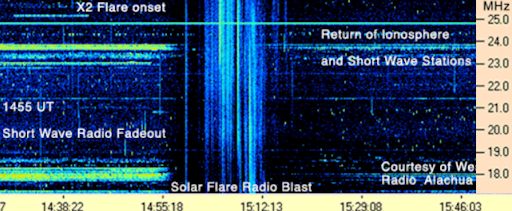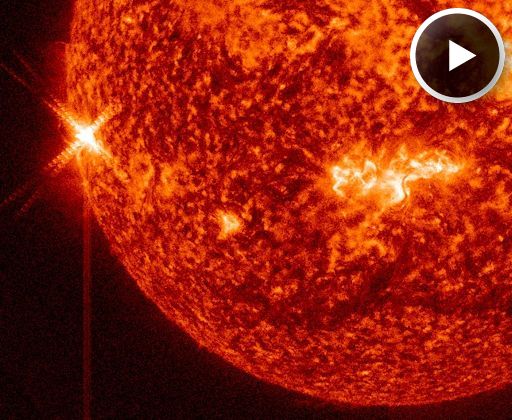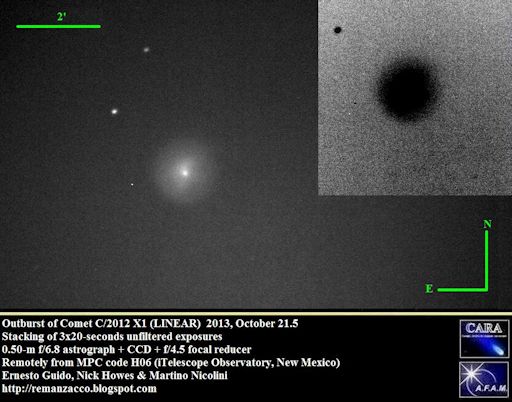When is the best time to see auroras? Where is the best place to go? And how do you photograph them? These questions and more are answered in a new book, Northern Lights - a Guide, by Pal Brekke & Fredrik Broms. | | |
X-FLARE UPDATE: New sunspot AR1882 isn't very big, but it is potent. The active region has already unleashed two strong solar flares today: An X1 at 08:01 UT followed by an X2 at 15:07 UT. There is no reason to think this fusillade will end soon, so stay tuned for more flares. Solar Flare alerts: text, voice.
X2-FLARE BLASTS EARTH'S IONOSPHERE: Electromagnetic radiation from today's X2-class solar flare had a significant effect on Earth's upper atmosphere. As a wave of ionization swept across the dayside of the planet, the normal propagation of shortwave radio signals was scrambled. In Alachua, Florida, electrical engineer Wes Greenman recorded the effects using his own shortwave radio telescope. Click on the frequency-time plot to view an animation:

During the time that terrestrial shortwave transmissions were blacked out, the sun filled in the gap with a loud radio burst of its own. In New Mexico, amateur radio astronomer Thomas Ashcraft recorded the sounds. "This radio burst was a strong one and might be too intense for headphones," cautions Ashcraft.
Solar radio bursts are caused by strong shock waves moving through the sun's atmosphere. (Electrons accelerated by the shock front excite plasma instabilities which, in turn, produce shortwave static.) They are usually a sign that a CME is emerging from the blast site--and indeed this flare produced a very bright CME. Solar flare alerts: text, voice.
Realtime Space Weather Photo Gallery
GLOBAL ERUPTION ON OCT 25TH: Solar activity is high and intensifying. New sunspot AR1882, which rotated over the sun's eastern limb earlier today, promptly unleashed an X1-class solar flare, adding to a series of lesser flares already underway from sunspots AR1875 and AR1877. NASA's Solar Dynamics Observatory recorded a bright flash of extreme UV radiation from the X1 flare, which peaked at 08:01 UT on Oct. 25th:

There may be more to this flare than meets the eye. Watch this movie of the sun's entire disk. The X1-flare was bracketed by two erupting magnetic filaments, each located hundreds of thousands of kilometers from AR1882. In other words, the X1 flare might have been just one piece of an interconnected global eruption.
More flares are in the offing. There are now three sunspot groups on the Earthside of the sun capable of strong eruptions: AR1875, AR1877 and AR1882. NOAA forecasters estimate a 55% chance of M-flares and a 10% chance of X-flares during the next 24 hours. Solar flare alerts: text, voice.
Realtime Space Weather Photo Gallery
COMET EXPLOSION: Almost 450 million km from Earth, Comet C/2012 X1 (LINEAR) has exploded. Amateur astronomers are reporting a 100-fold increase in the comet's brightness compared to predictions, and the comet's atmosphere or "coma" now resembles that of exploding Comet 17P/Holmes in 2007. Using a remotely-controlled 0.5 meter telescope in New Mexico, European observers Ernesto Guido, Martino Nicolini and Nick Howes took this picture of the spherical explosion on Oct 21st:

"The predicted magnitude of the comet on Oct. 20th was about +14," says Guido. "Now it is close to +8.5." This is below the threshold for naked-eye visibility, but bright enough for backyard telescopes equipped with digital cameras.
Prompted by the reports of Guido et al, Romanian amateur astronomer Maximilian Teodorescu observed the comet on Oct. 22nd, confirming its brightness and spherical structure. "It looked exactly like Comet Holmes back in 2007," says Teodorescu.
Located in the constellation Coma Berenices, Comet LINEAR X1 rises in the east about an hour before the sun. The low altitude of the comet in morning twilight is a challenge. "I could not see the comet through the eyepiece of my 4.5 inch refracting telescope," adds Teodorescu, "but the camera detected it easily enough."
The outburst does not necessarily signal a disintegration of the comet. Possibly, a local vein or cavern of deep ice in the comet's nucleus has been exposed to sunlight. Rapid evaporation of fragile ices could account for the comet's bigger- and brighter-than-expected atmosphere. Monitoring in the nights ahead might reveal clues to what happened ... and when. Resources: 3D orbit, ephemeris, sky map.
Realtime Comet Photo Gallery
Realtime Comet ISON Photo Gallery
Realtime Aurora Photo Gallery
NEW: Every night, a network of
NASA all-sky cameras scans the skies above the United States for meteoritic fireballs. Automated software maintained by NASA's Meteoroid Environment Office calculates their orbits, velocity, penetration depth in Earth's atmosphere and many other characteristics. Daily results are presented here on Spaceweather.com.
On Oct. 25, 2013, the network reported 28 fireballs.
(17 sporadics, 8 Orionids, 1 Leonis Minorid, 1 epsilon Geminid, 1 lamda Draconid)

In this diagram of the inner solar system, all of the fireball orbits intersect at a single point--Earth. The orbits are color-coded by velocity, from slow (red) to fast (blue). [Larger image] [movies]
Potentially Hazardous Asteroids (
PHAs) are space rocks larger than approximately 100m that can come closer to Earth than 0.05 AU. None of the known PHAs is on a collision course with our planet, although astronomers are finding
new ones all the time.
On October 25, 2013 there were potentially hazardous asteroids.
Notes: LD means "Lunar Distance." 1 LD = 384,401 km, the distance between Earth and the Moon. 1 LD also equals 0.00256 AU. MAG is the visual magnitude of the asteroid on the date of closest approach. | | The official U.S. government space weather bureau |
| | The first place to look for information about sundogs, pillars, rainbows and related phenomena. |
| | Researchers call it a "Hubble for the sun." SDO is the most advanced solar observatory ever. |
| | 3D views of the sun from NASA's Solar and Terrestrial Relations Observatory |
| | Realtime and archival images of the Sun from SOHO. |
| | from the NOAA Space Environment Center |
| | the underlying science of space weather |

